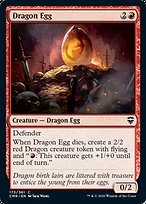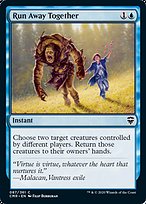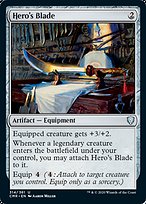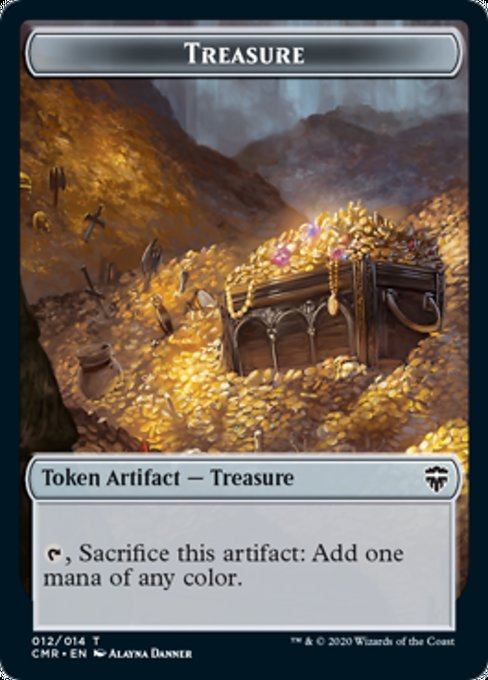























































































































Commander Legends is an extra-large set with 141 commons, 120 uncommons (40 of which are legendary creatures), 77 rares (25 of which are legendary creatures), 22 mythic rares (5 of which are legendary creatures or planeswalkers that can be your commander), and one card of special rarity (The Prismatic Piper). (An additional 32 reprinted legendary creatures can appear in draft boosters only with the foil-etched treatment.) Every pack contains a foil card. The set was printed in English in the USA and Belgium.
Commander Legends was sold in 20 card booster packs (which contain an additional ad card). Booster boxes have 24 packs.
The US printing uses sequential collation.
Packs are front-facing and have common-uncommon-rare ordering followed by two legendary cards, a foil, and an ad card. There are 13 commons, 3 uncommons, and 1 rare. The legendary cards may be additional uncommons, rares, or mythics. If The Prismatic Piper appears, it will appear after the foil, displacing a common.
| 13 Commons | 3 Uncommons | 1 Rare | 2 Legends | 1 Foil | 1 Ad Card | |||||||||||||||
| 12 Commons | 3 Uncommons | 1 Rare | 2 Legends | 1 Foil | The Prismatic Piper | 1 Ad Card | ||||||||||||||
There are three common runs: A, B, and C. Packs have 5-6 A cards followed by 5-6 B cards and 2 C cards. Ignoring Prismatic Pipers, half of packs have 5 A and 6 B, and the other half have 6 A and 5 B. Pipers can displace a card from any run. This will never result in 4 A cards or 4 B cards, but it can result in 1 C card.
The A and B runs each contain 60 distinct cards (each appearing twice), and the C run contains the remaining 21 commons. Without Prismatic Pipers, this makes C commons too likely. Assuming Pipers appear in 1/6 of packs (a claim discussed further in regard to the Belgian printing), 25/47 of Pipers should displace C cards (with the rest evenly divided between A and B) to ensure all commons are equally rare. The C common run appears to repeat after ever card appears once. (Because of this repetition, though, it is hard to confirm I have seen the full sheet.)
In a string of 22 consecutive packs, the A and B runs are likely to each go through exactly 120 cards plus one Prismatic Piper. This means they often repeat exactly on a pack boundary within the same box. In the same 22 packs, the C run is likely to go through 42 cards plus two Prismatic Pipers meaning it will also repeat at the same time. As a consequence, it is relatively common for the first two and last two packs in a box to have identical or nearly identical commons.
The 80 non-legendary uncommons are divided into an A run and a B run. Packs contain either two A followed by B or one A followed by two B.
The legendary slot collates uncommons, rares, and mythics separately. Uncommons come first followed by the mythic, and the rare is last. There can be at most 1 mythic (confirmed in a tweet by Gavin Verhey) (accompanied by either an uncommon or a rare). There can be two rares in the same pack (which appear to be consecutive cards from the same run). If there are two uncommons in the same pack, they will also be consecutive from the same run. Empirically, the average number of uncommons per pack in my observation was very close to 1.5 which makes these uncommons about as rare as the non-legendary uncommons.
The A common run consists of 60 different cards each appearing twice. The choice of first card is mostly arbitrary.
 |  |  |  |  |  |  |  |  |  |  |
 |  |  |  |  |  |  |  |  |  |  |
 |  |  |  |  |  |  |  |  |  |  |
 |  |  |  |  |  |  |  |  |  |  |
 |  |  |  |  |  |  |  |  |  |  |
 |  |  |  |  |  |  |  |  |  |  |
 |  |  |  |  |  |  |  |  |  |  |
 |  |  |  |  |  |  |  |  |  |  |
 |  |  |  |  |  |  |  |  |  |  |
 |  |  |  |  |  |  |  |  |  |  |
 |  |  |  |  |  |  |  |  |  |
The B common run consists of 60 different cards each appearing twice. The choice of first card is mostly arbitrary.
 |  |  |  |  |  |  |  |  |  |  |
 |  |  |  |  |  |  |  |  |  |  |
 |  |  |  |  |  |  |  |  |  |  |
 |  |  |  |  |  |  |  |  |  |  |
 |  |  |  |  |  |  |  |  |  |  |
 |  |  |  |  |  |  |  |  |  |  |
 |  |  |  |  |  |  |  |  |  |  |
 |  |  |  |  |  |  |  |  |  |  |
 |  |  |  |  |  |  |  |  |  |  |
 |  |  |  |  |  |  |  |  |  |  |
 |  |  |  |  |  |  |  |  |  |
The C common run consists of 21 different cards. It appears to repeat every 21 cards, though this is hard to confirm. I have observed one example of a skip from Path of Ancestry to Staunch Throneguard, but 2 missing cards don't seem to make sense with a normal sheet size. The choice of first card is mostly arbitrary.
 |  |  |  |  |  |  |  |  |  |  |
 |  |  |  |  |  |  |  |  |  |
The A uncommon run consists of 40 non-legendary uncommons each appearing three times. The choice of first card is mostly arbitrary.
 |  |  |  |  |  |  |  |  |  |  |
 |  |  |  |  |  |  |  |  |  |  |
 |  |  |  |  |  |  |  |  |  |  |
 |  |  |  |  |  |  |  |  |  |  |
 |  |  |  |  |  |  |  |  |  |  |
 |  |  |  |  |  |  |  |  |  |  |
 |  |  |  |  |  |  |  |  |  |  |
 |  |  |  |  |  |  |  |  |  |  |
 |  |  |  |  |  |  |  |  |  |  |
 |  |  |  |  |  |  |  |  |  |  |
 |  |  |  |  |  |  |  |  |  |
The B uncommon run consists of 40 non-legendary uncommons each appearing three times. The choice of first card is mostly arbitrary.
 |  |  |  |  |  |  |  |  |  |  |
 |  |  |  |  |  |  |  |  |  |  |
 |  |  |  |  |  |  |  |  |  |  |
 |  |  |  |  |  |  |  |  |  |  |
 |  |  |  |  |  |  |  |  |  |  |
 |  |  |  |  |  |  |  |  |  |  |
 |  |  |  |  |  |  |  |  |  |  |
 |  |  |  |  |  |  |  |  |  |  |
 |  |  |  |  |  |  |  |  |  |  |
 |  |  |  |  |  |  |  |  |  |  |
 |  |  |  |  |  |  |  |  |  |
The Belgian printing uses sequential collation.
Packs are front-facing and have common-uncommon-rare ordering followed by two legendary cards, a foil, and an ad card. There are 13 commons, 3 uncommons, and 1 rare. The legendary cards may be additional uncommons, rares, or mythics. If The Prismatic Piper appears, it will appear after the foil, displacing a common.
| 13 Commons | 3 Uncommons | 1 Rare | 1 Land | 2 Legends | 1 Foil | 1 Ad Card | |||||||||||||||
| 12 Commons | 3 Uncommons | 1 Rare | 1 Land | 2 Legends | 1 Foil | The Prismatic Piper | 1 Ad Card | ||||||||||||||
There are three common runs: A, B1, and B2. Half of packs contain cards from A and B1 and the other half have A and B2. In either case, there are 5-6 cards from A followed by 7-8 card from B. Half of packs have 5 A cards and half have 6 A cards (independent of B1 versus B2). If The Prismatic Piper appears, it displaces a B card (which can be B1 or B2).
The A common run contains 60 different cards each appearing twice plus one copy of the short-printed common, Jalum Tome. The B1 common run contains 40 different cards each appearing three times plus one copy of Jalum Tome. The B2 common run contains an additional 40 different cards (and probably one filler). This makes Jalum Tome a 5/6 short print (which is the same short-printing rate that occurs in many 101 common printings).
If The Prismatic Piper appears in 1/6 of packs, a number given as (approximately) by official sources, and ignoring the short-printed common, all other commons are equally rare. Because the short-printed common appears in A and B1 but not B2, B2 cards should be a bit more common. (This could partly mitigated by putting more Pipers in B2 packs, but this is purely speculation.)
The 80 non-legendary uncommons are divided into an A run and a B run. Packs contain either two A followed by B or one A followed by two B.
Like the US printing, the legendary slot collates uncommons, rares, and mythics separately. Rares come first followed by uncommons, and the mythic is last. Otherwise, the behavior appears to be the same as the US printing (with different runs).
In the normal rare slot, mythics and rares appear to share sheets, so it seems likely that each rare appears twice as often as each mythic (which divides evenly into 121 card sheets).
The A common run consists of 60 different cards each appearing twice plus Jalum Tome, the short-printed common. The choice of first card is mostly arbitrary.
 |  |  |  |  |  |  |  |  |  |  |
 |  |  |  |  |  |  |  |  |  |  |
 |  |  |  |  |  |  |  |  |  |  |
 |  |  |  |  |  |  |  |  |  |  |
 |  |  |  |  |  |  |  |  |  |  |
 |  |  |  |  |  |  |  |  |  |  |
 |  |  |  |  |  |  |  |  |  |  |
 |  |  |  |  |  |  |  |  |  |  |
 |  |  |  |  |  |  |  |  |  |  |
 |  |  |  |  |  |  |  |  |  |  |
 |  |  |  |  |  |  |  |  |  |  |
The B1 common run consists of 40 different cards each appearing three times plus Jalum Tome, the short-printed common. The choice of first card is mostly arbitrary.
 |  |  |  |  |  |  |  |  |  |  |
 |  |  |  |  |  |  |  |  |  |  |
 |  |  |  |  |  |  |  |  |  |  |
 |  |  |  |  |  |  |  |  |  |  |
 |  |  |  |  |  |  |  |  |  |  |
 |  |  |  |  |  |  |  |  |  |  |
 |  |  |  |  |  |  |  |  |  |  |
 |  |  |  |  |  |  |  |  |  |  |
 |  |  |  |  |  |  |  |  |  |  |
 |  |  |  |  |  |  |  |  |  |  |
 |  |  |  |  |  |  |  |  |  |  |
The B2 common run consists of 40 different cards each appearing three times. The choice of first card is mostly arbitrary.
 |  |  |  |  |  |  |  |  |  |  |
 |  |  |  |  |  |  |  |  |  |  |
 |  |  |  |  |  |  |  |  |  |  |
 |  |  |  |  |  |  |  |  |  |  |
 |  |  |  |  |  |  |  |  |  |  |
 |  |  |  |  |  |  |  |  |  |  |
 |  |  |  |  |  |  |  |  |  |  |
 |  |  |  |  |  |  |  |  |  |  |
 |  |  |  |  |  |  |  |  |  |  |
 |  |  |  |  |  |  |  |  |  |  |
 |  |  |  |  |  |  |  |  |  |
The A uncommon run consists of 40 non-legendary uncommons each appearing three times. The choice of first card is mostly arbitrary.
 |  |  |  |  |  |  |  |  |  |  |
 |  |  |  |  |  |  |  |  |  |  |
 |  |  |  |  |  |  |  |  |  |  |
 |  |  |  |  |  |  |  |  |  |  |
 |  |  |  |  |  |  |  |  |  |  |
 |  |  |  |  |  |  |  |  |  |  |
 |  |  |  |  |  |  |  |  |  |  |
 |  |  |  |  |  |  |  |  |  |  |
 |  |  |  |  |  |  |  |  |  |  |
 |  |  |  |  |  |  |  |  |  |  |
 |  |  |  |  |  |  |  |  |  |
The B uncommon run consists of 40 non-legendary uncommons each appearing three times. The choice of first card is mostly arbitrary.
 |  |  |  |  |  |  |  |  |  |  |
 |  |  |  |  |  |  |  |  |  |  |
 |  |  |  |  |  |  |  |  |  |  |
 |  |  |  |  |  |  |  |  |  |  |
 |  |  |  |  |  |  |  |  |  |  |
 |  |  |  |  |  |  |  |  |  |  |
 |  |  |  |  |  |  |  |  |  |  |
 |  |  |  |  |  |  |  |  |  |  |
 |  |  |  |  |  |  |  |  |  |  |
 |  |  |  |  |  |  |  |  |  |  |
 |  |  |  |  |  |  |  |  |  |
The legendary uncommon run consists of 40 legendary uncommon creatures each appearing three times. The choice of first card is mostly arbitrary.
 |  |  |  |  |  |  |  |  |  |  |
 |  |  |  |  |  |  |  |  |  |  |
 |  |  |  |  |  |  |  |  |  |  |
 |  |  |  |  |  |  |  |  |  |  |
 |  |  |  |  |  |  |  |  |  |  |
 |  |  |  |  |  |  |  |  |  |  |
 |  |  |  |  |  |  |  |  |  |  |
 |  |  |  |  |  |  |  |  |  |  |
 |  |  |  |  |  |  |  |  |  |  |
 |  |  |  |  |  |  |  |  |  |  |
 |  |  |  |  |  |  |  |  |  |
The marketing cards in Commander Legends have a token (or Monarch card) on the front face. They are printed on an 11 × 11 sheet with different items appearing different numbers of times.
 |  |  |  |  |  |  |  |  |  |  |
 |  |  |  |  |  |  |  |  |  |  |
 |  |  |  |  |  |  |  |  |  |  |
 |  |  |  |  |  |  |  |  |  |  |
 |  |  |  |  |  |  |  |  |  |  |
 |  |  |  |  |  |  |  |  |  |  |
 |  |  |  |  |  |  |  |  |  |  |
 |  |  |  |  |  |  |  |  |  |  |
 |  |  |  |  |  |  |  |  |  |  |
 |  |  |  |  |  |  |  |  |  |  |
 |  |  |  |  |  |  |  |  |  |  |
| Token Rarity | ||
|---|---|---|
 Angel × 2 Angel × 2 |  Dragon × 2 Dragon × 2 |  Horror × 2 Horror × 2 |
 Thrull × 3 Thrull × 3 |  Rock × 4 Rock × 4 |  Golem × 5 Golem × 5 |
 Salamander Warrior × 5 Salamander Warrior × 5 |  Spirit × 9 Spirit × 9 |  Elf Warrior × 12 Elf Warrior × 12 |
 Zombie × 12 Zombie × 12 |  Soldier × 15 Soldier × 15 |  Treasure × 15 Treasure × 15 |
 Copy × 17 Copy × 17 |  The Monarch × 18 The Monarch × 18 | |
| Tokens (With Reverse Side) |
|---|
|